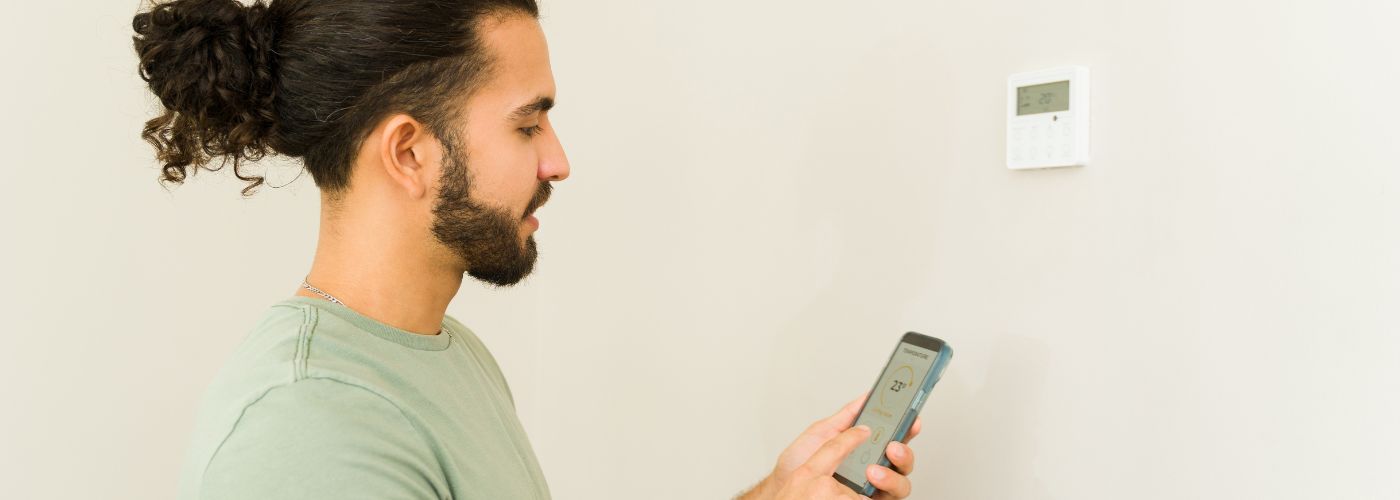Taking your first steps to modernizing your home is wonderful as it’s full of joy and remarkable memories. We’ll be going over tips to prepare your home for smart wifi thermostat installation. We’ll go over things like assessing your current wifi network strength, checking for dead zones, choosing the right smart devices to integrate, and more!
Steps To Prepare Your Home For Smart Wifi Thermostat Installation
One of the best tips to prepare your home for smart wifi thermostat installation is to assess the layout of your home and identify the optimal location.
Be sure to check if you have a C-wire or common wire, which is necessary for most smart thermostats to function properly. If your current system lacks a C-wire, you may need to have one installed by a professional.
Lastly, consider investing in a WiFi extender if needed to enhance signal coverage throughout your home. By taking these steps to prepare your home for smart WiFi thermostat installation, you can set yourself up for a seamless transition to more efficient and convenient temperature control technology.
Make Sure Your Thermostat Is Compatible Before Installation
Before you prepare your home for smart wifi thermostat installation, it’s crucial to ensure that your current heating and cooling system is compatible with a smart wifi thermostat.

Check the specifications of your system and the thermostat you plan to install to avoid any potential complications during the setup. This step is essential in ensuring that your new device functions seamlessly and provides all the features it promises.
Typically, the HVAC technician or company checks the compatibility before installing the new smart wifi system. While it’s always important to trust the HVAC company, it doesn’t hurt to check for it yourself if you’re worried about the installation process.
Assess Your Home’s Wi-Fi Needs and Coverage Areas
Before diving into installing a smart Wi-Fi thermostat, it is crucial to assess your home’s Wi-Fi needs and coverage areas. Understanding the strength of your wireless connection throughout different parts of your house will help you determine the best location for the thermostat installation.
Conducting a thorough evaluation will ensure that the device can connect seamlessly to your network without any interruptions.
Moreover, optimizing your home’s Wi-Fi signal strength is essential for smooth operation of the smart thermostat. Consider installing Wi-Fi range extenders or mesh networking devices to boost connectivity in areas with weak signals.
By addressing these issues beforehand, you can guarantee a reliable connection for controlling your thermostat remotely and enjoying all the benefits of a smart heating and cooling system. Remember, a solid foundation of strong Wi-Fi coverage is one of the best ways to prepare your home for smart wifi thermostat installation.
Consider Upgrading Your Router For Better Coverage
Before delving into the installation process of a smart WiFi thermostat, it is crucial to consider the capabilities of your current router. To ensure optimal performance and coverage for your new device, it may be worth upgrading to a more powerful router with higher Mbps (megabits per second) capacity.
This can help prevent connectivity issues and provide a seamless experience when controlling your thermostat remotely. Investing in a reliable router is essential for maximizing the potential of your smart home devices.
Another important step is to assess the location where you plan to place the device. Choose a spot that is centrally located and free from obstructions to ensure even distribution of WiFi signals throughout your home.
The recommended Mbps for the average home is around 100-250 Mbps, but this can vary depending on the size of your home, the number of connected devices, and your internet usage habits.
Consult with your Internet Service Provider (ISP) or a tech expert to determine the best router for your specific needs.
Secure Your Smart Network Against Hackers
One crucial step to prepare your home for smart WiFi thermostat installation is to secure your smart network against potential hackers.
With the rise of IoT devices, such as smart thermostats, ensuring the security of your network is essential to protect your personal information and maintain privacy. Start by changing default passwords on your router and all connected devices to strong, unique passwords that are difficult for hackers to guess.
Another important consideration is to enable network encryption, such as WPA3, to safeguard your data from unauthorized access. Regularly updating firmware on both the thermostat and your router can also help patch vulnerabilities and enhance security measures.
By taking these proactive steps, you can enjoy the convenience of a smart thermostat while minimizing the risks associated with cyber threats and enjoy your smart wifi thermostat and AC installation!
Test Your Devices Post Smart Thermostat Installation
Once the smart WiFi thermostat is installed in your home, it’s essential to thoroughly test all your devices to ensure they are properly connected and functioning with the new system.
Start by checking each room’s temperature to confirm that the smart thermostat is effectively controlling the heating or cooling.
Next, test the connectivity of your smartphone or tablet with the thermostat app to make adjustments remotely. While checking your system, it’s best to see if you need AC maintenance to avoid issues.
Ensure that any other compatible devices, such as voice assistants or smart plugs, are seamlessly integrating with the thermostat for full automation and control. By conducting these tests post-installation, you can guarantee a smooth and efficient operation!


